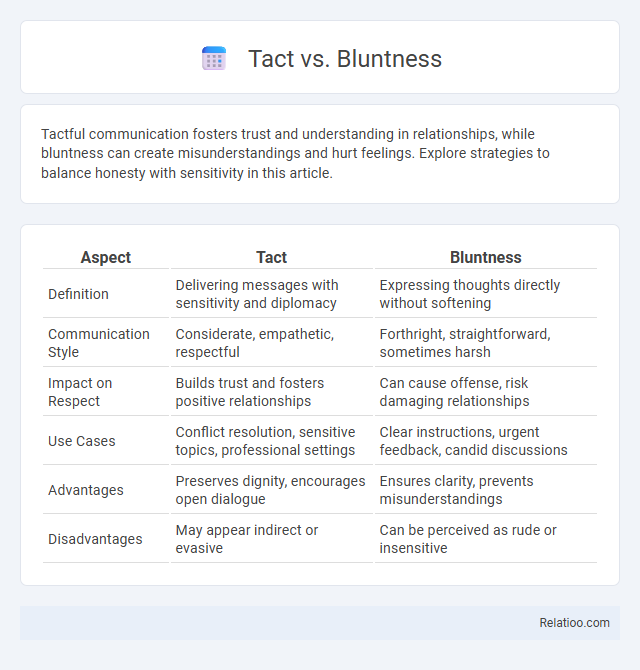Tactful communication fosters trust and understanding in relationships, while bluntness can create misunderstandings and hurt feelings. Explore strategies to balance honesty with sensitivity in this article.
Table of Comparison
| Aspect | Tact | Bluntness |
|---|---|---|
| Definition | Delivering messages with sensitivity and diplomacy | Expressing thoughts directly without softening |
| Communication Style | Considerate, empathetic, respectful | Forthright, straightforward, sometimes harsh |
| Impact on Respect | Builds trust and fosters positive relationships | Can cause offense, risk damaging relationships |
| Use Cases | Conflict resolution, sensitive topics, professional settings | Clear instructions, urgent feedback, candid discussions |
| Advantages | Preserves dignity, encourages open dialogue | Ensures clarity, prevents misunderstandings |
| Disadvantages | May appear indirect or evasive | Can be perceived as rude or insensitive |
Understanding Tact and Bluntness
Understanding tact involves recognizing the importance of delivering messages with sensitivity and consideration, which helps maintain positive relationships and prevent misunderstandings. Bluntness, in contrast, prioritizes straightforwardness and honesty, often at the expense of softer communication, which can sometimes cause discomfort or offense. You can improve your communication effectiveness by balancing tact with bluntness, ensuring clarity while respecting others' feelings.
The Psychology Behind Communication Styles
Tact in communication reflects emotional intelligence, allowing you to convey messages considerately while maintaining clarity and respect. Bluntness often stems from a preference for directness, which can foster efficiency but may risk offending others if sensitivity is overlooked. Understanding these psychological communication styles helps you balance honesty with empathy, enhancing interpersonal relationships and reducing conflicts.
Benefits of Practicing Tact in Conversations
Practicing tact in conversations enhances interpersonal relationships by promoting understanding and minimizing conflicts. Tactful communication fosters a positive atmosphere, encouraging open dialogue and trust between parties. This approach improves problem-solving and collaboration by addressing sensitive topics with empathy and respect.
Potential Drawbacks of Being Too Tactful
Excessive tact can lead to ambiguity, as overly cautious communication may obscure the intended message, causing misunderstandings or lack of clarity. Being too tactful might also hinder timely decision-making, since important issues are often softened or avoided to prevent discomfort. This approach can reduce authenticity and trust, as others may perceive the speaker as insincere or evasive.
Advantages of Blunt Communication
Blunt communication offers clear and straightforward messaging that minimizes misunderstandings and saves time by cutting through vague or ambiguous language. Your direct approach can build trust by demonstrating honesty and transparency, especially in high-stakes or urgent situations. While tact prioritizes diplomacy, bluntness excels in delivering unfiltered feedback efficiently, which can accelerate decision-making and problem-solving.
The Risks of Excessive Bluntness
Excessive bluntness can damage professional relationships by causing misunderstanding and resentment due to its direct and often harsh nature. You risk alienating colleagues or clients when feedback lacks tact, potentially hindering collaboration and trust. Balancing honest communication with empathy enhances rapport and promotes a positive work environment while conveying critical messages effectively.
Tact vs Bluntness in Professional Settings
Tact enhances Your communication in professional settings by promoting diplomacy and sensitivity, which helps maintain positive relationships and prevents misunderstandings. Bluntness, while straightforward and efficient, risks offending colleagues and damaging workplace rapport due to its direct and often harsh nature. Balancing tact and bluntness ensures clear communication without compromising respect or professionalism.
Navigating Personal Relationships: Finding the Balance
Navigating personal relationships requires balancing tact and bluntness to communicate effectively without causing unintended offense. Tact involves expressing your thoughts thoughtfully and respectfully, preserving feelings while addressing issues, whereas bluntness prioritizes honesty and directness, which can sometimes strain bonds. Finding this balance empowers you to maintain trust and openness while ensuring clarity and understanding in your interactions.
Tips for Cultivating Effective Communication
Tact enhances communication by balancing honesty with sensitivity, ensuring your message is clear without offending others. Bluntness can deliver straightforward information but risks alienating your audience if not tempered with empathy. Cultivating effective communication involves active listening, considering others' feelings, and choosing words that respect both clarity and kindness for your interactions.
Choosing the Right Approach for Every Situation
Tact involves delivering your message with sensitivity and consideration, ensuring your communication is respectful and effective in diverse social contexts. Bluntness prioritizes honesty and directness, which can be valuable when clarity and quick understanding are crucial but may sometimes risk offending others. You should assess the situation carefully, balancing honesty with empathy to choose the right approach that maintains relationships and achieves your communication goals.

Infographic: Tact vs Bluntness
 relatioo.com
relatioo.com